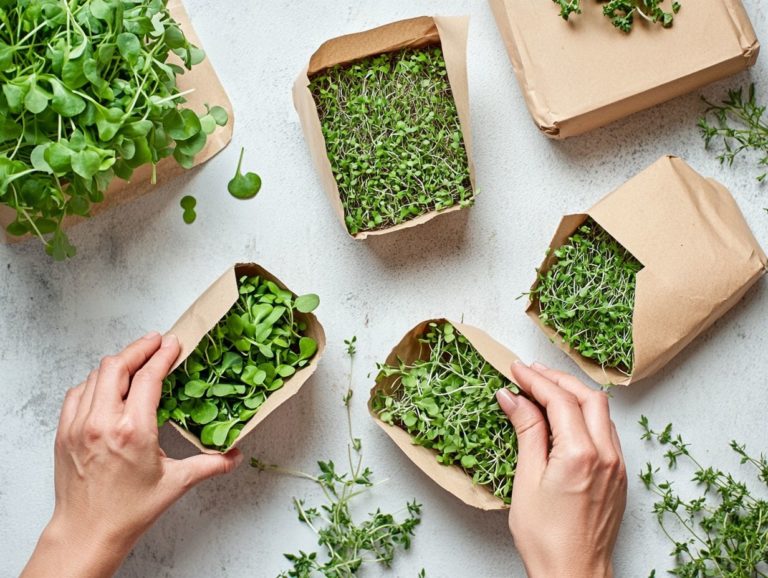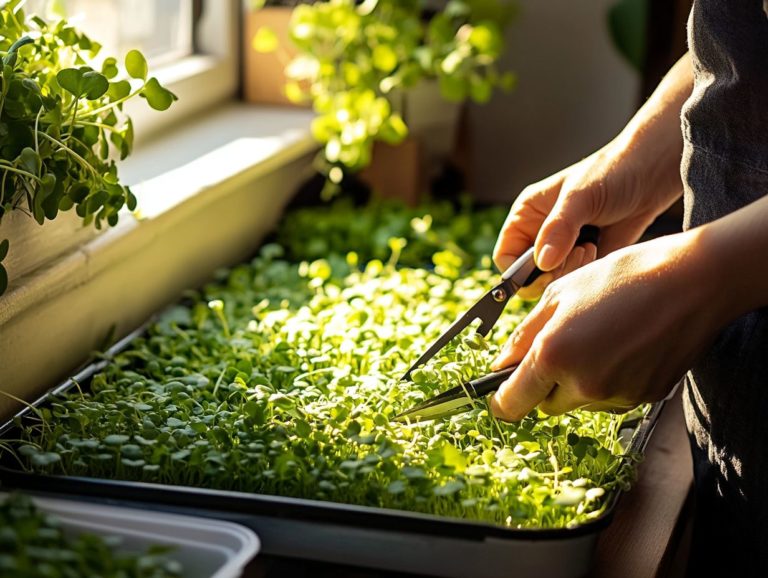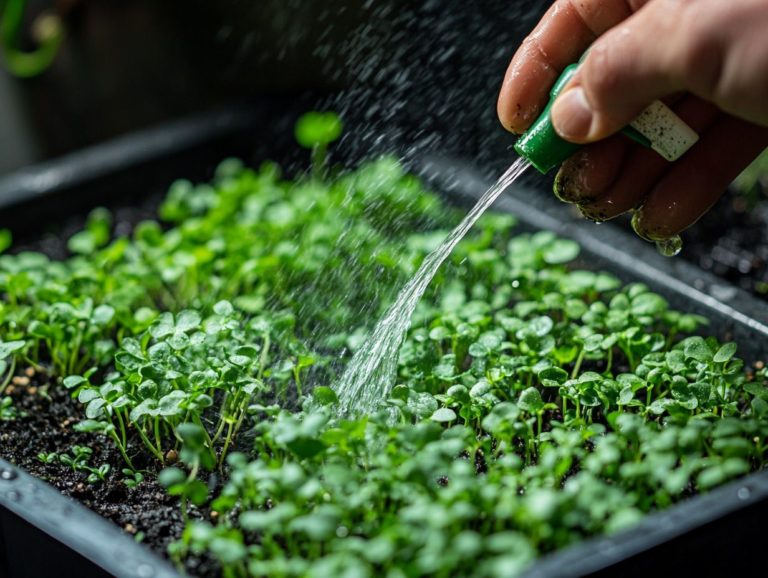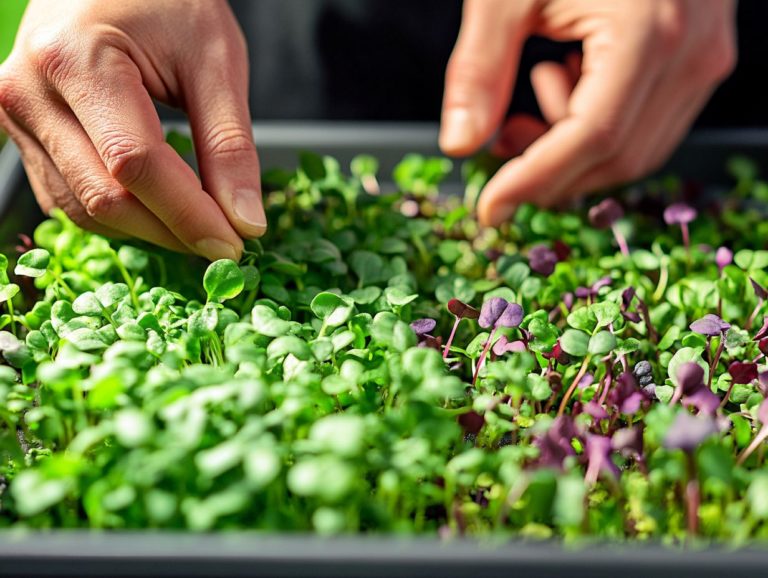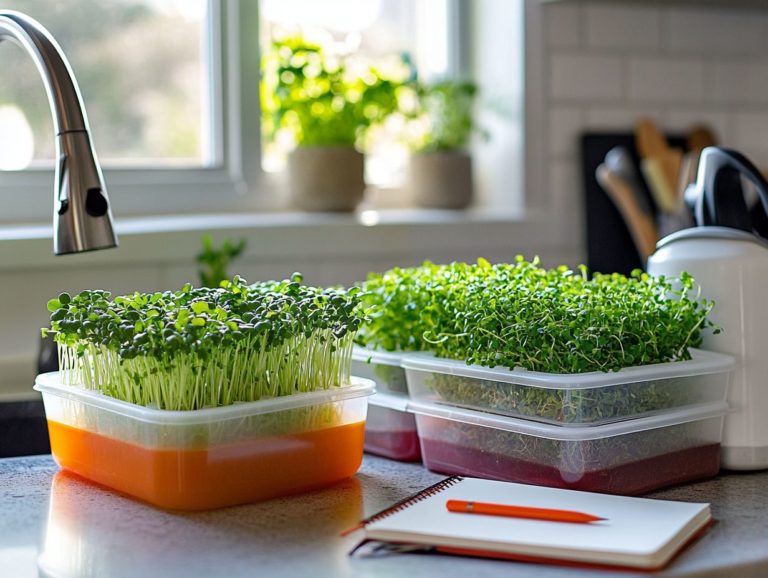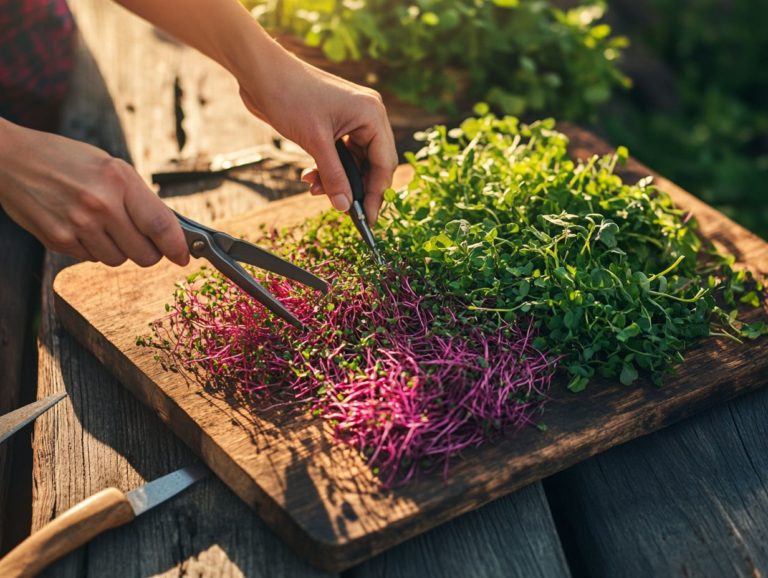5 Creative Uses for Harvested Microgreens
Microgreens are not merely a fashionable garnish; they offer a remarkable burst of flavor and nutrients that can truly enhance a variety of dishes.
Here are five inventive ways to incorporate these petite powerhouses into your meals, whether it s enriching your salads, soups, or creating one-of-a-kind pestos and infused oils.
You ll discover how to grow and harvest your own microgreens, delve into their impressive health benefits, and gather tips on proper storage and safe consumption.
Discover the incredible versatility of microgreens!
Contents
Key Takeaways:
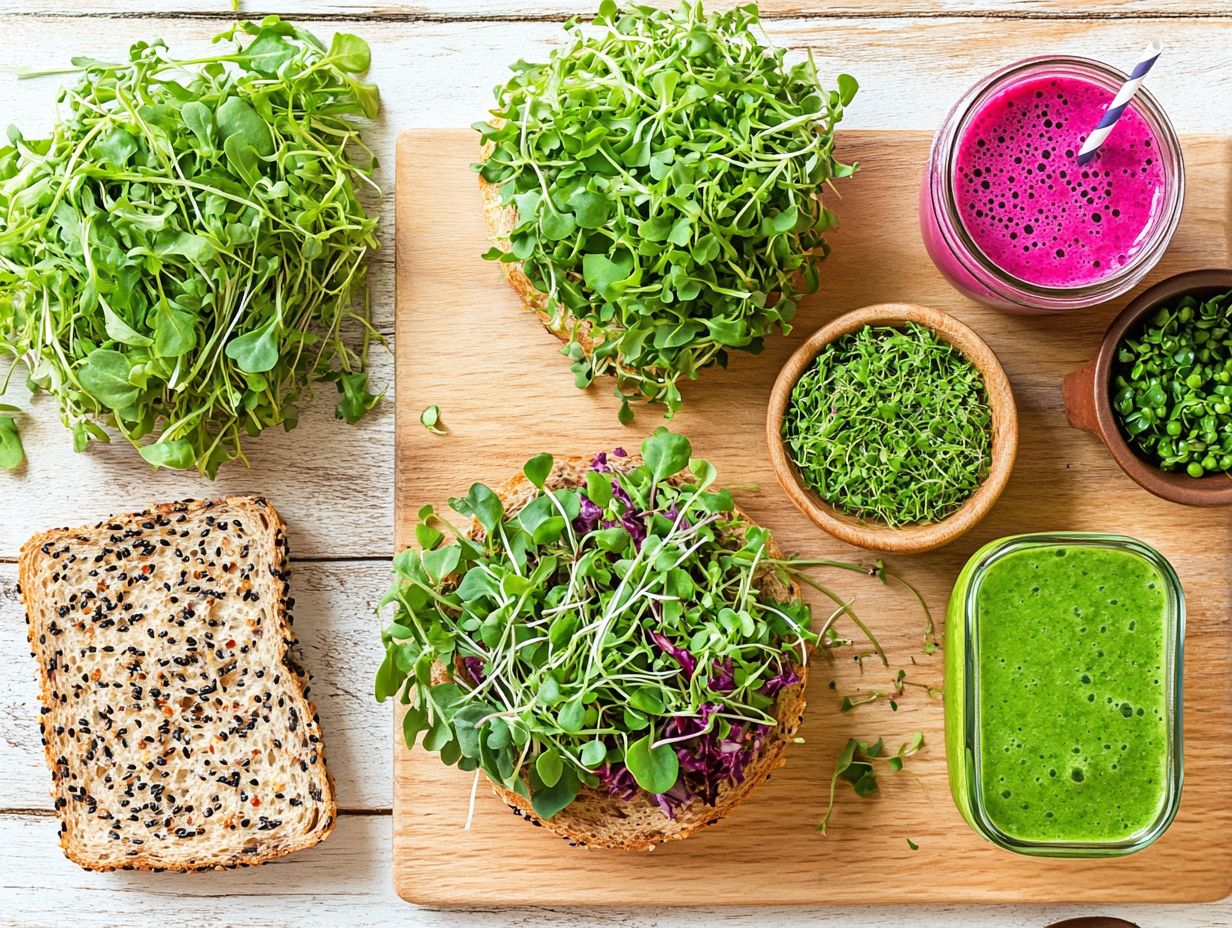
- Microgreens boost flavors and nutrients in salads.
- Use them as a beautiful garnish for soups.
- Get creative by adding microgreens to smoothies and unique sauces.
1. Add Flavor and Health Benefits to Salads
Adding microgreens to your salads isn’t just a clever way to elevate flavor; it’s also a brilliant method to enhance the health benefits of your meal. These tiny greens are bursting with vitamins, minerals, and antioxidants that contribute to your overall health and well-being. Incorporate varieties like arugula, spinach, or broccoli microgreens to transform your salad into a health powerhouse while tantalizing your taste buds.
Take pea shoots; they bring a sweet crunch that brightens up your salad. Meanwhile, radish microgreens offer a zesty kick, perfectly complementing creamy dressings. If you’re looking to elevate your culinary creations even further, consider exploring 5 unique microgreen varieties for exotic flavors and experiment with combinations, such as pairing sunflower microgreens with cherry tomatoes and feta, to add visual appeal and enhance the dish’s flavor.
Imagine crafting a delightful salad with a mixed greens base topped with basil microgreens, roasted beets, and a sprinkle of goat cheese, all drizzled with balsamic vinaigrette. These petite wonders are full of nutrients, rich in vitamins K, C, and E, making them essential components of a balanced meal.
2. Use as a Garnish for Soups and Entrees
Microgreens add visual appeal and flavor to your soups and entrees, elevating your dishes to new levels of taste.
These tiny, nutrient-rich plants bring vibrant color and texture, transforming a simple bowl of tomato bisque or creamy potato leek soup into a feast for the senses. Varieties like cilantro microgreens deepen the flavor of a spicy black bean soup, while radish microgreens provide a zesty crunch that complements a savory beef stew. For more ideas, check out cooking with microgreen varieties.
For seafood dishes, delicate pea shoots infuse a sweet brightness into a classic clam chowder, showcasing the versatility of these little greens. Thoughtfully paired, microgreens can turn any meal into a gourmet experience, captivating your guests with both taste and aesthetics.
3. Incorporate into Smoothies and Juices
Incorporating microgreens into your smoothies and juices is a brilliant way to infuse your beverages with essential nutrients, transforming them into delicious, health-boosting additions to your daily diet.
These tiny greens, bursting with vitamins, minerals, and antioxidants, bring diverse flavors that elevate any drink. For instance, the peppery zing of arugula adds a spicy kick, while sweet pea shoots lend a fresh sweetness.
When blended just right, these microgreens enhance nutritional value and the overall taste experience. Pairing them with fruits like bananas or berries creates a delightful balance, effectively masking bold flavors while amplifying health benefits.
Try a refreshing green smoothie loaded with spinach, avocados, and a hint of basil for an aromatic twist. Invest in a high-speed blender and feel free to experiment with various fruit and green combinations that suit your taste preferences.
Try adding microgreens to your next meal and experience the difference!
4. Create Unique Pesto and Herb Sauces
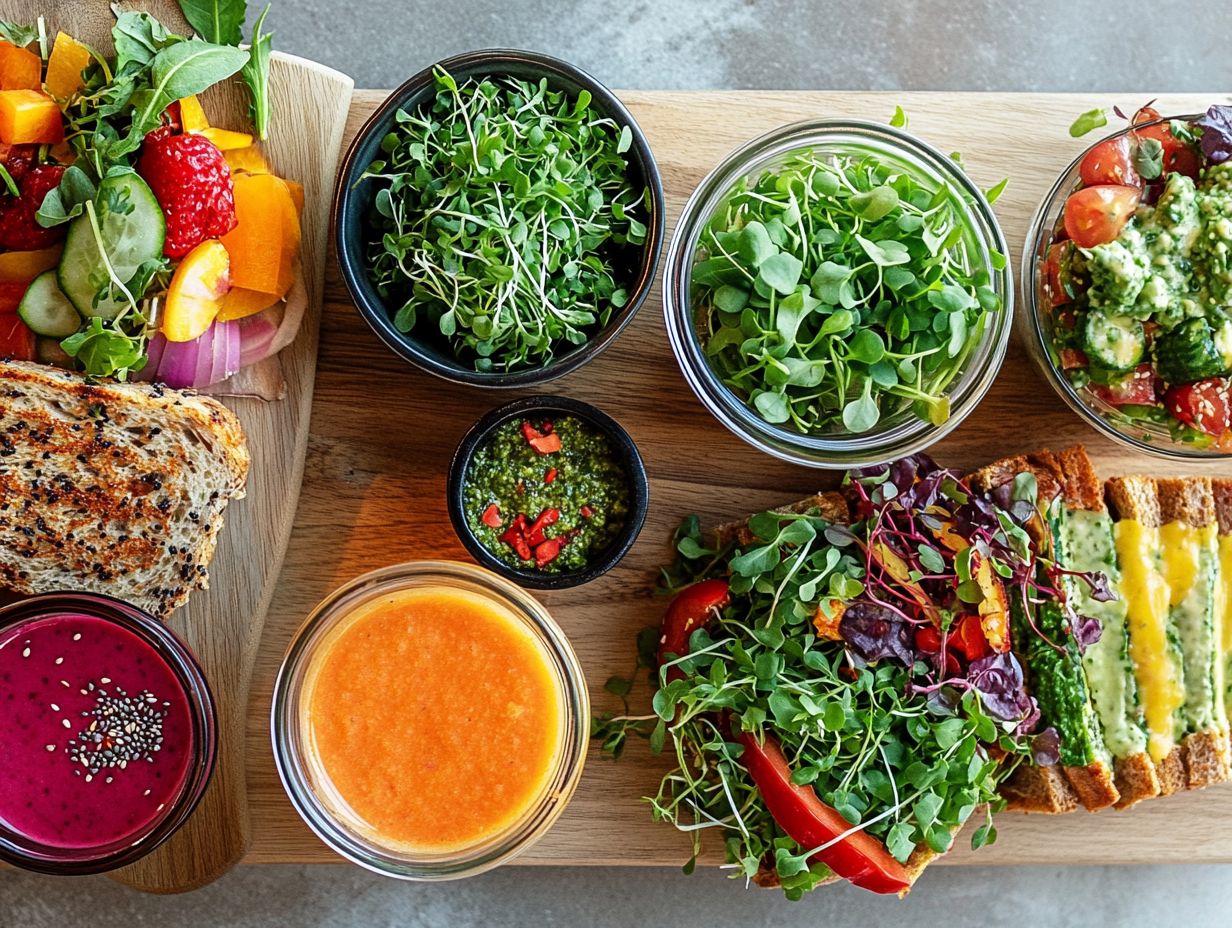
Make unique pesto and herb sauces using microgreens. This gives classic recipes a fresh twist.
Microgreens like arugula, basil, or radish greens can elevate your sauces. Arugula adds a peppery bite, while basil brings a sweet profile that enhances any Italian dish.
Sunflower microgreens offer a nutty richness for creamy sauces. Dill microgreens provide a fresh, citrusy kick for your dishes.
Experiment with these greens for a pesto that celebrates freshness and offers a complex flavor palette. Try blending arugula microgreens with walnuts and olive oil for zest, or mix dill microgreens with yogurt and garlic for a tangy dip. For an added twist, consider using unique microgreens to elevate your dishes. Get creative! Your options are endless!
5. Make Microgreen Infused Oils and Vinegars
Create microgreen-infused oils and vinegars to capture the vibrant flavors of microgreens. This technique elevates your dishes with a refreshing burst and notable health benefits.
To start, gently simmer or steep microgreens in your choice of oil or vinegar. Select fresh microgreens such as basil, cilantro, or radish each known for its distinctive taste. For oil infusions, choose a light olive oil or grapeseed oil. For vinegars, consider high-quality apple cider or white wine vinegar. To enhance your microgreen growing skills, explore innovative methods for hydroponic microgreens.
After immersing the microgreens, let your mixture rest in a cool, dark place for about a week to develop rich flavors. Store your creations in sealed, dark glass bottles to maintain quality.
These infused products can transform simple salads or serve as delightful drizzles over roasted vegetables. Why not start your own infused oils today?
How to Grow and Harvest Microgreens
Growing and harvesting microgreens at home is rewarding. It s a delightful way to enhance your meals with fresh ingredients while nurturing your own edible plants, contributing to a sustainable lifestyle.
With just a few materials and simple techniques, you can easily embark on this enjoyable journey. Start by selecting a suitable growing medium, whether it s soil or a hydroponic mat a soil-less growing medium tailored to the microgreens you choose.
Position your trays in a spot that receives at least four to six hours of sunlight daily. If natural light is insufficient, consider investing in grow lights. Mist the seedlings regularly to keep the soil moist but avoid sogginess for optimal growth.
Timing is crucial; plan to harvest within seven to fourteen days, depending on the variety, to savor the best flavors and nutrient content. Keep moisture consistent and ensure good airflow for a thriving growth cycle.
What Are the Best Microgreens to Grow?
When deciding which microgreens to grow, select varieties based on flavor, ease of cultivation, and health benefits. This choice can significantly elevate your homegrown experience and enhance your meals.
Standout options include pea shoots, cilantro, and radish microgreens. Pea shoots add a sweet, tender flavor that refreshes salads and sandwiches. Cilantro microgreens deliver a bright, zesty burst to elevate any dish. For those looking to enhance their meals even further, learning how to incorporate microgreens into your diet can be a game changer. Radish microgreens offer a delightful peppery kick for depth in your culinary masterpieces.
Each of these microgreens is packed with essential vitamins and antioxidants, making them not only delicious but also nutritious additions to your diet. For a flavorful salad, consider exploring must-try microgreen varieties. To ensure successful growth, pay attention to proper lighting and moisture levels. Be sure to harvest them at the right time to maximize their flavor.
What Are the Health Benefits of Microgreens?
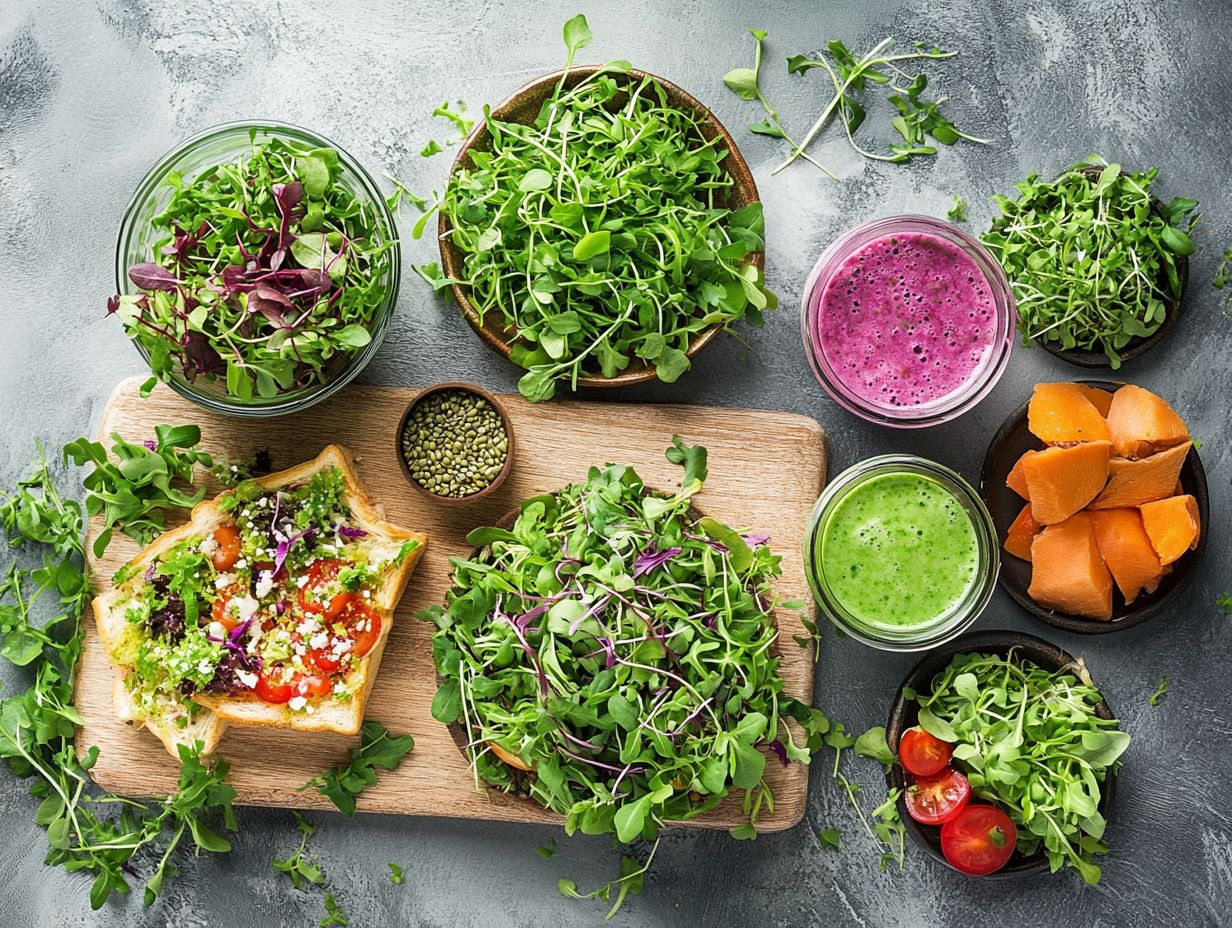
Microgreens are a nutritional powerhouse, offering a wealth of health benefits. They are high in vitamins, minerals, and antioxidants, all contributing positively to your overall health and wellness.
Tiny greens like broccoli and radish pack a nutrient punch. A study published in the Journal of Agricultural and Food Chemistry revealed that microgreens can have up to 40 times more nutrients than mature vegetables.
Take broccoli microgreens, for example; they are rich in a natural compound linked to cancer prevention. Pea shoots offer a delightful boost of vitamins A, C, and K. For a tasty way to incorporate these, consider the top 5 microgreen varieties for breakfast. Adding these nutrient-dense foods to your diet boosts your immune system and improves skin health, showcasing the significant impact these small greens can have on your well-being.
What Are Some Other Creative Ways to Use Microgreens?
Microgreens are your secret weapon in the kitchen, offering a plethora of creative uses that go far beyond salads. They transform your meals with their unique flavors and vibrant colors while boosting nutritional value.
Imagine how zesty microgreens can transform your meals! Picture microgreens topping your gourmet sandwiches, delivering a delightful crunch that contrasts beautifully with softer ingredients. Elevate a classic BLT with radish greens or arugula for a peppery kick that surprises the palate. Discover ways to enhance flavor in microgreens to take your dishes to the next level.
When you sprinkle microgreens over pasta dishes, you’re adding not just visual appeal, but also layers of flavor. Think of basil microgreens enhancing a creamy carbonara, creating a harmonious blend of tastes. For added texture, toss microgreens into stir-fries or use them as a garnish on tacos. This refreshing element can elevate your everyday dining experience and inspire culinary experimentation. To learn more about growing these vibrant additions, check out 5 creative ways to grow microgreens.
Can Microgreens Be Stored for Later Use?
Storing microgreens properly is essential for maintaining their freshness and nutritional value. This allows you to relish their health benefits long after the harvest.
For optimal storage, keep them in a cool, dark place ideally in the refrigerator. Temperatures between 32 F and 39 F are perfect for preserving their vitality. Use breathable containers like perforated bags (these bags have small holes to let air circulate) or clamshells to prevent moisture buildup, which can lead to spoilage. Generally, most microgreens will stay fresh for about 5 to 14 days, depending on the variety.
If you’re looking to extend their shelf life even further, freezing is a viable option. Just wash and dry them, then blanch briefly before placing them in airtight containers. This way, you can enjoy microgreen varieties and their culinary uses even months after they’ve been harvested.
Are There Any Precautions to Take When Consuming Microgreens?
While microgreens can be a delightful and nutritious addition to your meals, it s essential to take some important precautions to avoid any potential health risks and ensure a safe eating experience.
Contaminants sometimes hide in these vibrant greens, so it’s vital to be vigilant about their source. Always purchase microgreens from reputable vendors who adhere to strict food safety standards. When selecting your microgreens, look for vibrant colors and fresh leaves, as these are indicators of quality. Give them a thorough wash under running water to help remove any lingering pesticide residues and bacteria.
For that extra layer of safety, consider soaking them briefly in a vinegar and water solution before rinsing. This simple step ensures you re adding the healthiest ingredients possible to your meals.
Frequently Asked Questions
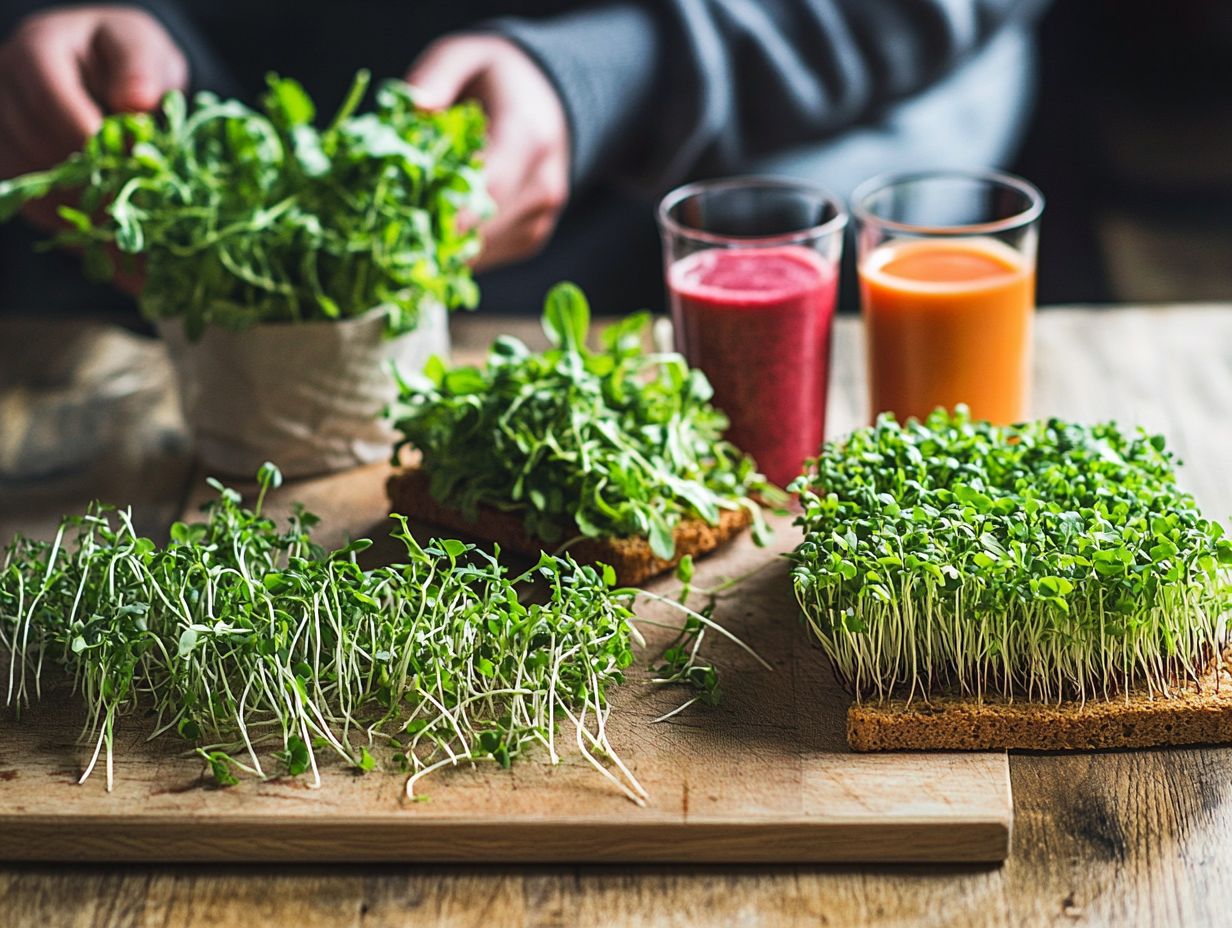
Why are microgreens so popular and what are they?
Microgreens are young and tender plants that are harvested after the first few leaves have grown. They are popular because they are packed with nutrients, easy to grow, and add a burst of flavor to any dish.
How to Use Harvested Microgreens in Your Cooking
Unlock endless possibilities with harvested microgreens! Add them to your salads, sandwiches, smoothies, and omelets for a burst of flavor.
Can Microgreens Be Used in Non-Food Items?
Microgreens can also be used in non-food items. Consider them as a natural dye for fabrics or infused into oils for skincare products.
You can even use microgreens as a colorful addition to homemade soaps!
Are There Any Health Benefits to Using Microgreens in My Meals?
Absolutely! Microgreens are packed with vitamins, minerals, and antioxidants.
Antioxidants help protect your cells from damage. They also have anti-inflammatory properties and can aid digestion.
Can I Grow My Own Microgreens at Home?
Absolutely! Growing your own microgreens at home is fun and easy.
You’ll enjoy fresh greens in just a few weeks with a sunny spot, a container, soil, and seeds.
What Are Some Unique Ways to Use Harvested Microgreens?
Aside from cooking, harvested microgreens can serve multiple purposes.
Use them as a natural pest repellent in your garden, as a nutritious addition to your pet’s food, or as a colorful topping for homemade pizzas!

